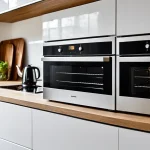Transforming British Kitchens with Advanced Technology
British kitchens are rapidly evolving thanks to cutting-edge kitchen technologies that prioritize convenience and efficiency. These innovations integrate seamlessly with daily routines, making cooking and cleaning more intuitive. For example, smart ovens that adjust cooking time based on recipe data or refrigerators that monitor groceries have become increasingly common, reflecting the trend towards smart kitchen innovations.
Current British kitchen trends favor designs that incorporate technology without compromising aesthetic appeal. Homeowners seek sleek, minimalist layouts paired with smart appliances that promote energy efficiency and reduce waste. This fusion of style and function exemplifies how technology is reshaping kitchen roles—from a mere cooking space to a central hub of household management.
This might interest you : Discover how uk kitchens are embracing renewable energy innovations
The rapid adoption of voice-activated assistants and automated systems underscores the shift to technology-driven kitchens. This trend enables users to control appliances hands-free, schedule meal preparation, and even receive maintenance alerts. As a result, these advancements enhance user experience while encouraging sustainable practices in British homes. The future of kitchens lies in integrating these smart devices that simplify everyday tasks with precision and adaptability.
Key Innovations Leading the Change
Smart appliances have revolutionised daily routines by introducing efficiency and convenience to kitchens. Their integration into homes allows users to automate and personalise cooking processes, reducing manual effort. For example, IoT kitchen solutions enable remote control and monitoring, so ovens or refrigerators can be adjusted via smartphones, saving time and enhancing meal preparation.
This might interest you : Discovering modern innovations: how uk kitchens are evolving with current trends
Connected kitchen devices, especially those with app-controlled features, empower users to track inventory, set precise cooking times, and receive alerts. This innovation not only reduces food waste but also streamlines multitasking during busy days. Voice-activated commands further simplify interactions, allowing cooks to control appliances hands-free, improving workflow and hygiene.
Combining smart appliances with IoT kitchen solutions fosters a cohesive ecosystem where devices communicate and optimise household tasks collaboratively. This connectivity optimises energy consumption and ensures appliances operate at peak performance. Emerging trends focus on enhanced user interfaces and increased device interoperability, signalling ongoing transformation in kitchen management.
Real-world Applications in British Homes
Explore how modern kitchen case studies reveal the growing shift in British homes towards innovative technology. Several UK kitchen tech examples showcase smart appliances seamlessly integrated into everyday routines, enhancing convenience and efficiency. These kitchen transformation stories highlight not only aesthetic improvements but also functional upgrades, such as smart ovens that adapt cooking times or fridges that monitor food freshness.
In urban areas, adoption rates tend to be higher due to better access to technology and infrastructure. Homeowners in cities often embrace connected devices that sync with smartphones, enabling remote control and monitoring. Conversely, rural kitchens may prioritize robust, standalone tech solutions that suit less consistent internet availability.
Visual examples illustrate smart induction hobs replacing traditional stoves and voice-controlled lighting systems transforming kitchen ambiance. Embracing kitchen technology leads to time savings and reduced energy consumption, common goals across British households.
These real-world applications underscore the practical benefits of upgrading kitchens with technology tailored to specific needs, demonstrating a clear trend in UK kitchen tech examples where innovation meets everyday living.
Evaluating Benefits for British Consumers
Smart kitchen technology benefits are transforming British kitchens by introducing unparalleled convenience and efficiency. Incorporating intelligent appliances simplifies daily cooking tasks, allowing users to multitask without stress. For example, smart ovens with preset cooking programs ensure perfectly cooked meals every time, reducing guesswork and saving time.
Convenience in British kitchens also includes remote control features, such as managing refrigerators or dishwashers via smartphone apps. This level of control means meals can be prepped and devices monitored without constant kitchen supervision, giving homeowners more freedom in their busy lives.
Efficient kitchen solutions contribute significantly to energy conservation and sustainability. Advanced sensors optimize appliance performance, minimizing energy waste and lowering utility bills. Additionally, eco-friendly modes on devices support environmentally conscious lifestyles—aligning with growing sustainability values among British consumers.
Lifestyle improvements are notable as these technologies integrate seamlessly into daily routines. Smart kitchen technologies encourage healthier eating habits through meal-planning apps and connected gadgets that track nutritional information, demonstrating a genuine enhancement beyond mere convenience. This modern approach makes cutting-edge kitchen tech not just a luxury, but a practical asset for British households seeking smarter living.
Challenges and Considerations in Kitchen Tech Adoption
When adopting smart kitchen devices, British homeowners often face distinct challenges that can slow integration. One major barrier is technology integration itself—new gadgets must work seamlessly with existing appliances, yet compatibility issues frequently arise. This creates frustration and limits the full benefits of smart kitchens.
Data privacy and security are among the most pressing UK consumer concerns. Connected kitchen devices collect sensitive information, such as usage patterns and even voice commands. Homeowners worry about unauthorized access or breaches, which can discourage adoption despite the convenience these appliances offer.
Additionally, cost remains a significant obstacle. Initial investment, coupled with ongoing maintenance and updates, can deter many from embracing new kitchen tech. Buyers must weigh these expenses against the potential time-saving and energy-efficient advantages.
Overall, overcoming these challenges requires manufacturers to prioritize ease of integration, robust security, and transparent pricing. Educating UK consumers about these factors can help build trust and encourage wider acceptance of smart kitchen technology.
Expert Insights on the Future of British Kitchens
British kitchen technology experts foresee a transformative decade ahead, with smart home future UK developments deeply influencing kitchen design. These specialists emphasize integration of intelligent systems to enhance convenience, energy efficiency, and personalized cooking experiences. Kitchen design opinions increasingly highlight the fusion of elegance with technology, catering to tech-savvy homeowners wanting seamless control over appliances and environment.
Home automation professionals in the UK predict that kitchens will evolve into multifunctional hubs, combining cooking, entertainment, and wellness. Sensors and AI-powered devices will anticipate user needs, adjusting lighting, temperature, and even suggesting recipes. This shift will prioritize sustainability, with smart fridges reducing food waste and energy-efficient appliances becoming standard.
Incorporating insights from experts reveals a trend towards open layouts that support connectivity and social interaction while embedding advanced technology discreetly. The focus remains on making kitchens intuitive and adaptive, reflecting lifestyle changes and environmental concerns. Overall, the UK kitchen technology experts agree that the smart home future UK centers on creating spaces that are not only functional but also responsive and enjoyable.
Key Features to Look for in a Robot Hoover
When choosing a robot hoover, prioritize features that directly impact cleaning efficiency and convenience. First, consider the suction power. A higher suction power ensures better performance on various floor types, from carpets to hard floors. Users often ask, “Does suction power significantly affect cleaning quality?” The answer is yes: stronger suction results in more thorough debris removal.
Navigation technology is another vital element. Modern robot hoovers use laser-guided or camera-based systems for precise movement and room mapping. This minimizes missed spots and collision with obstacles. If you’re wondering how navigation systems improve cleaning efficiency, they allow the device to clean methodically rather than randomly.
Battery life matters too. A longer battery life means extended cleaning sessions and the ability to cover larger areas without recharging. Many models also return automatically to their docks, ensuring they’re ready for the next cycle.
Additional features like app control, scheduling, and multi-surface adaptability enhance usability. Prioritizing these aspects ensures you select a robot hoover tailored to your lifestyle and cleaning needs.


